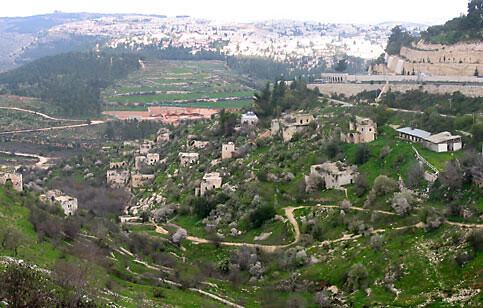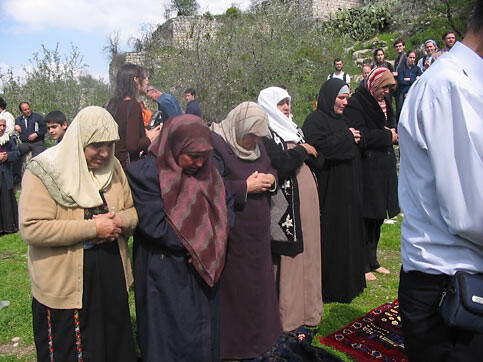The Electronic Intifada 2 March 2005

Lifta village today. (Photo: Jacob Pace)
On the morning of Friday, February 25, 2005 a group of approximately 300 Israelis, Palestinian refugees and international activists gathered near the highway leading out of Jerusalem towards Tel Aviv. In the valley below lay the ruins of the ancient Palestinian village of Lifta. The event was part tour, part protest, and part homecoming. It had different meanings for each of the groups involved.
The organization responsible for planning the event, Zochrot (Hebrew for “Remembering”) takes Israelis on tours of depopulated and partially destroyed Palestinian villages. They bring Palestinian refugees to tell the stories of their village and plant signs in Arabic and Hebrew that explain what happened there. This event, however, was also a protest aimed at stopping the impending demolition of what remains of Lifta.
The village is scheduled to be removed and/or “renovated.” The demolition of Lifta, sponsored by the Israel Lands Administration, is part of the Israeli government’s development plan for West Jerusalem. It calls for the construction of 243 villas (each 200 m2), a hotel, museum and Synagogue. The heart of Lifta’s old city will be renovated and turned into a trendy mall for high-priced Israeli crafts and other goods.
For the Palestinian refugees who came on Friday, however, the event was primarily an opportunity to visit their village. To be sure, they accompanied the marchers and carried signs protesting the demolition plans, and they participated in Zochrot’s program by sharing their stories and knowledge of Lifta and their life before 1948.
Most of the refugees, however, left the group and wandered the ruins of the village. Most went first to their family homes. They brought their children and relayed small anecdotes about the houses. They cleaned rubbish from the inside and the front stoop and sat silently inside the houses or outside the doors.

Muslim women pray in Lifta. (Photo: Jacob Pace)
“We are only able to visit the village about once a year,” a refugee man told me as he held his baby and gazed out the window of his family’s home, “It is too dangerous to come alone because of the [Israeli] settlers that are usually here, so we have to wait for a group before we can come.”
Indeed, many Palestinian refugees from Lifta are not allowed to visit at all. The people who came on Friday lived in East Jerusalem, meaning they could travel to the village without passing through any Israeli checkpoints. Many of Lifta’s villagers, however, fled farther into the West Bank and beyond. Israel does not permit them to pass through the checkpoints and their village remains a cloudy reality passed down through the generations in stories and memories.
Lifta is not unique. Like 417 other Palestinian towns and villages, Lifta was forcibly depopulated and ethnically cleansed in 1948 to make way for the state of Israel.[1] In fact, in many ways, to tell the story of Lifta is to tell the story of Al Nakba, the Palestinian “Catastrophe” of 1948.
Depopulating Lifta
According to the refugees from Lifta, the village was once one of the largest and wealthiest communities in the Jerusalem region. The beauty of the old homes still standing upon the overgrown hillside pays tribute to that prosperous past. In fact, Lifta’s lands once covered 8,743 dunum (8.7 km2) and stretched from the hills west of Jerusalem right up to the gates of the old city itself. The population of the village in 1948 was approximately 2,550 (including 2,530 Muslim and 20 Christian Palestinians). Like most Palestinian villages, many of Lifta’s residents were dependent on agriculture and cultivated 3,000 dunums (3 km2) of land, including 1,500 olive trees.[2]
According to research compiled by Palestine Remembered, Lifta was originally a Canaanite village and during Biblical and Roman times it was known by the name Nephtoah. In the Byzantine period it was called Nephtho, and the Crusaders referred to Lifta as Clepsta. Before 1948, the village had been continuously inhabited for well over 2,000 years.
In the years leading up to the 1948 war, however, the village fell under attack by Jewish militias operating in the area. On the 28th of December, 1947 six people were gunned down in the village coffeehouse, by members of two Jewish militias, the Stern Gang (whose commander, Yitzhak Shamir, later became Prime Minister of Israel) and the Irgun (whose commander, Menachem Begin, also later served as Prime Minister of Israel).[3] Some of Lifta’s residents sold their property to European investors eager to acquire more land for Jewish settlement. Many more left early on. According to the descendents of the villagers, however, a significant number remained in Lifta into the first months of 1948.
The 1948 war which led to Israel’s declaration of independence in May 1948, started gradually. Jewish settlers were well organized and highly armed. The Jewish fighting forces included the Haganah (the official army of the Jewish settler community in Palestine) as well as several more radical militias (including the Stern Gang and Irgun). The militias were active in the area west of Jerusalem where Lifta was located.
Lifta was harassed by Stern Gang and Irgun militants through December 1947 and January 1948. One of the refugees who returned to the village last Friday, relayed the story he was told about the attack on Lifta:
In late January or early February, the Stern Gang and Irgun attacked and seized the neighboring village of Qaluba and then invaded Lifta from the West. They occupied Lifta’s new town and the remaining residents took refuge in the old town in the valley. The village was cut-off from the west and anyone trying to leave was killed. The villagers resisted but were defeated after 9 or 10 hours of fighting.
By the time the entire village was occupied, most of the people had already left Lifta and fled into the West Bank, the rest were taken by truck and dumped in East Jerusalem. By February 1948, Lifta had been completely depopulated.[4] The Stern Gang and Irgun occupied the houses and broke holes in the roofs to ensure that they would be uninhabitable if the residents attempted to return.
Lifta and Al Nakba
The story of Lifta was repeated in numerous villages throughout Palestine in 1948. At least 418 villages were ethnically cleansed in the same way.[5] In fact, the evacuation of Palestinian villages was a matter of policy for the Jewish fighting forces. Israeli historian Benny Morris explains that “in the months of April-May 1948, units of the Haganah [the predecessor to the Israeli Army]… were given operational orders that stated explicitly that they were to uproot the villagers, expel them and destroy the villages themselves.”[6]
Lifta, however, is unique in the fact that it was completely depopulated in February, at least two months before the war was in full-swing, and three months before Israel’s declaration of independence. In April of 1948, the Jewish forces were fighting several armies from newly independent Arab states. The Jewish settlers enjoyed substantive advantages in the war. Aside from possessing newer weapons and technology, they also outnumbered their Arab counterparts by a margin of two to one.[7] It was in this context that, the leader of the Jewish forces, David Ben-Gurion, commanded his fighters to “adopt the method of aggressive defense; with every [Arab] attack we must be prepared to respond with a decisive blow: the destruction of the [Arab] place or the expulsion of its residents along with the seizure of the place.”[8]
One of the most brutal incidents of the war occurred in April in the village of Deir Yassin, near Lifta. On April 9, the same militias which had earlier attacked Lifta (the Stern Gang and Irgun) invaded Deir Yassin. In the fighting that ensued, approximately 250 Palestinian villagers were massacred.[9] The Palestinian resistance fighters were taken in truck to East Jerusalem and shot. The massacre contributed to the flight of neighboring communities also threatened with destruction. In fact, Benny Morris has documented at least 24 massacres of Palestinian civilians during the 1948 war.[10]
By the end of the war Jewish forces controlled 77% of historic Palestine which became the state of Israel and 750,000 Palestinian civilians had been forced to flee their homes. Today, there are over 5 million Palestinian refugees, the descendants of the original 750,000. For these 5 million, and many other Palestinians, Al Nakba stands as the defining moment in their national identity.
The story of Lifta is only one among 418 stories of villages that only exist in memory. Unlike many of the depopulated villages, however, the buildings of Lifta were not demolished but still stand as a testament to the existence of the once affluent Palestinian village. If Israel’s plan proceeds even these remnants will be gone, wiped away in the favor of plush villas. In the meantime, Lifta’s refugees are waiting to return to their village, to rebuild their homes and to once again live in the 2,000 year old village they call home.
Jacob Pace lives in Beit Sahour and works with the Applied Research Institute-Jerusalem (ARIJ) in Bethlehem. His reports and photos are available online at www.rcnv.org/gaza.
Related Links
Footnotes
1. Walid Khalidi (ed). All That Remains: The Palestinian Villages Occupied and Depopulated by Israel in 1948. Washington DC: Institute for Palestine Studies, 1992. Cited in Masalha (pg 39- see note for discussion).
2. “Lifta.” Palestine Remembered (http://www.palestineremembered.com/Jerusalem/Lifta/index.html).
3. Ibid.
4. Ibid.
5. Khalidi, 1992.
6.“Survival of the Fittest” (Interview with Benny Morris). Ha’aretz. Thursday, January 8, 2004 (http://www.haaretz.com/hasen/spages/380986.html).
7. Avashai (pg 180).
8. Masalha (pg 19).
9. The New York Times. cited at Deir Yassin Remembered (www.deiryassin.org).
10. Ibid.



